The Lower Columbia River estuary has miles of back channels, broad expanses of shallow, wildlife-rich waters, a handful of charming, lightly touristed towns, and anchorages a-plenty for shallow-draft boats. When Frank and his wife, Julie—wide-ranging trailer-sailors from California—contacted me last spring, seeking advice about cruising in the Northwest, I signed on as their unofficial guide.
We rendezvoused at the Elochoman Slough Marina, in Cathlamet, Washington, a town of just 600 on the north bank of the Columbia River. Frank and Julie arrived in their little Subaru wagon with their Core Sound 20, WREN, in tow. The boat dwarfed the car and as they stepped the leg-o’-mutton cat-ketch rig at the top of the ramp, I felt a twinge of envy. With a sail area of 155 square feet, WREN might beat the pants off ROW BIRD, my 18′ Arctic Tern, a lug yawl carrying just 111 square feet of sail. And when I looked over WREN’s roomy cockpit and cabin, I suspected my new friends would not only be faster but also more comfortable to boot.
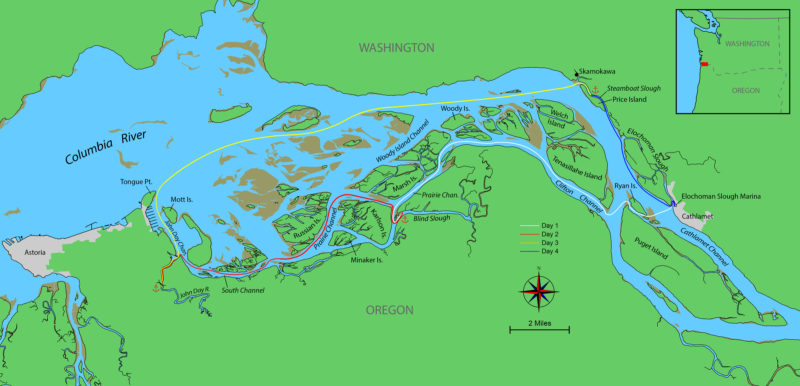 Roger Siebert
Roger Siebert.
To start our four-day tour of the Columbia River estuary, we planned to go downstream in the backwater sloughs and return upstream in the open waters surrounding the river’s main channel. Ours were the only boats in motion as we rowed through the marina’s mirror-smooth water. Lighter, and with a lower freeboard better suited for rowing, ROW BIRD moved far more swiftly. Frank had just gotten long, new carbon-fiber oars; he dug into the water at a steep angle from locks set on the high coaming, which made for slow going until he gained momentum.
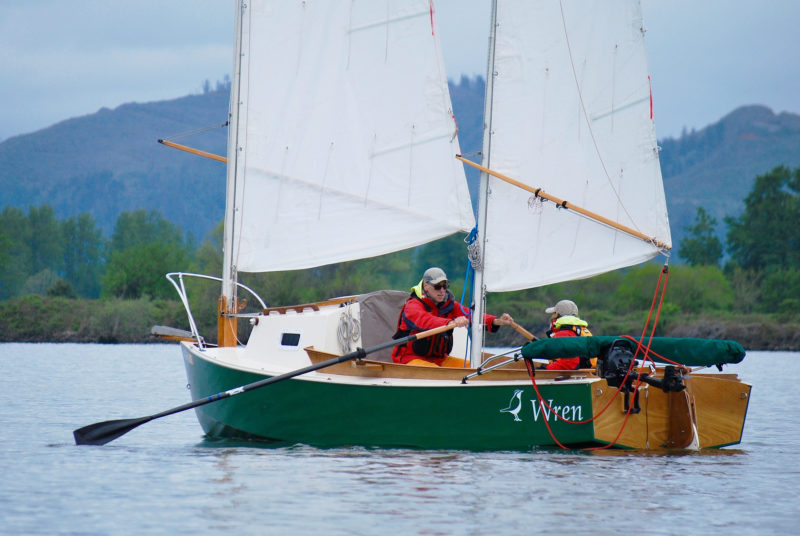 Bruce Bateau
Bruce BateauIn the lulls, Frank used his new sectional 10′4″ carbon-fiber oars. With boat, rig, food, and crew weighing in at 1,000 lbs, WREN is not a fast boat under oars, especially when carrying its 450 lbs of water ballast. The high cabin and double masts make it hard to row against the wind.
A thick grove of 60′-high cottonwoods, their leaves fluttering gently, reached down to the sandy shoreline. When that first tickle of a morning wind made the flag on my mizzen mast flicker, I quickly pulled my oars aboard, tucked the blades together in the bow, and unfurled the mizzen. I set the strop on the lugsail’s yard over the hook of the leather-wrapped mast traveler, and hauled away, raising the main. I kept an eye on WREN as I pulled away from Cathlamet and headed across the 1/2-mile-wide Cathlamet Channel. A patchwork quilt of logged forestry lands draped the hills on either side of the broad Columbia River valley.
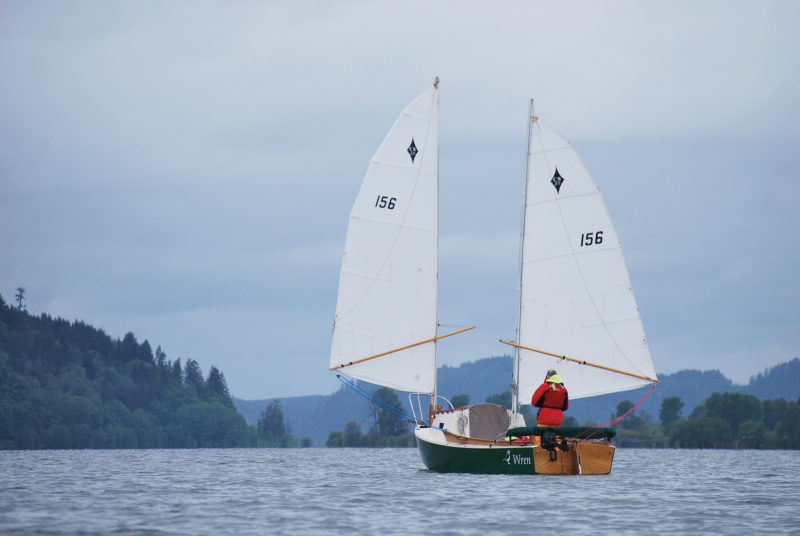 Bruce Bateau
Bruce BateauWith the Oregon shore to port and Tenasillahe Island to starboard, WREN sails wing-on-wing downriver along Clifton Channel.
It took WREN’s crew a few more moments to haul up each sail, adjust the sprit booms, and stow their oars than it did for me on ROW BIRD, and by the time WREN was halfway across, I was entering the unmarked slot between pastoral Puget Island and its low-lying neighbor, Ryan Island. Suddenly my centerboard struck a mudbank. “Plowing” is a common occurrence on the backwaters of the lower Columbia. Quickly, before I got stuck, I tacked into deeper water and startled Frank and Julie, who were approaching speedily. After completing another tack, I found the right entrance point, and they followed me toward the steep, conifer-rich hillside above Clifton Channel. A 1/3-mile-long wing dam of wooden piles at the mouth of the channel keeps most of the flow in the Columbia’s main stem. These structures pose a danger to boaters who might get pinned against them by the current or wakes, so when I called “Wing dam! Go wide!” they followed me around the upstream side and into the deserted open water of the channel.
Twice a day, the current in the river reverses as each flood tide pushes in from the Pacific Ocean, then races to the ocean with the ebb. For now, the ebb was working in our favor, carrying us downriver; the wind was light and variable and we drifted with our sails up, pulled more by the movement of the water than by any breeze. Low clouds revealing only patches of blue sky appeared over the leafy treetops of Tenasillahe Island to starboard. After about an hour, we entered Prairie Channel, aptly named as the islands flanking it are low, marshy grass-covered mounds that are often inundated by the tide. From the low seat of my boat they appeared as endless fields of grass. As beautiful as this is, it is wet and muddy and we wouldn’t land here. To avoid getting stuck in hidden shallows on the falling tide we wove around the hummocks.
Our destination for the night was Blind Slough, a rarely traveled 2-1/2-mile dead end with a remnant stand of ancient, moss-laden Sitka spruce trees that line the banks for the first mile. Due to the water-logged soil in which they grow, these trees are rarely more than 40′ high, despite their age. Nearby, a rust-streaked barge listed on the north shore, its deck overtaken by head-high grasses and willow shrubs. We skirted a low ridge of mud that had been exposed by the falling tide, and a grassy islet that obstructs the slough’s mouth, and passed a moored salmon-fishing boat; a net was neatly rolled on a giant spool at its bow. Farther up the slough, abandoned fishing and work boats were crumbling at the high-tide line. We anchored near the barge in 10′ of water. In the stillness, birdsongs filled the air. Before settling in for the night, we rafted up and stretched a big white tarp across both cockpits just as a thick mist settled in the slough.
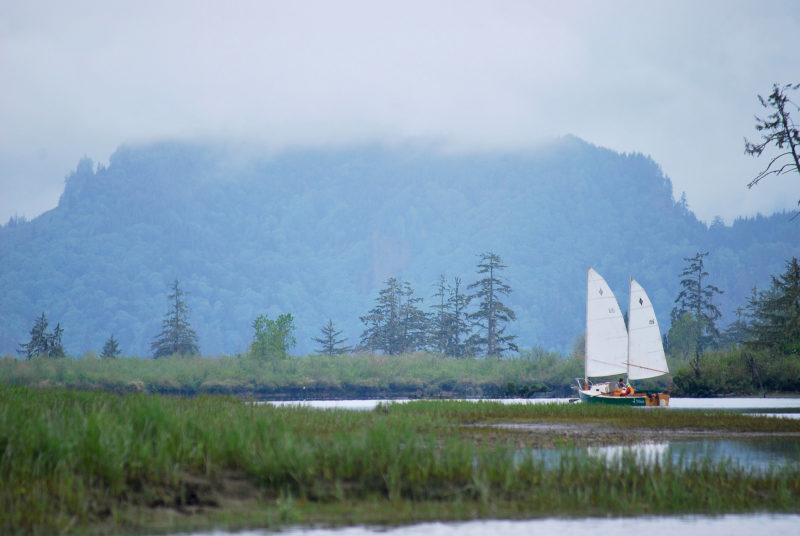 Bruce Bateau
Bruce BateauDrawing just 9″ with the centerboard up, WREN moves comfortably in shallow water, even under sail. Navigating around a mudflat, WREN enters Blind Slough.
As we were eating crackers and cheese and sipping wine, an outboard whined farther up the slough and a drab green duck-hunting boat soon approached, circled us, and slowed down nearby. A bearded man behind its wheel had a puzzled expression. l lifted a flap of the tarp and said, “I guess you don’t get many visitors here.” “Nope. You going to be here long?” he asked, without really waiting for answer. “That’s my bowpicker,” he said, pointing to the moored boat, “I’m going to be setting up some nets here tomorrow.” I assured him we’d be on our way early in the morning.
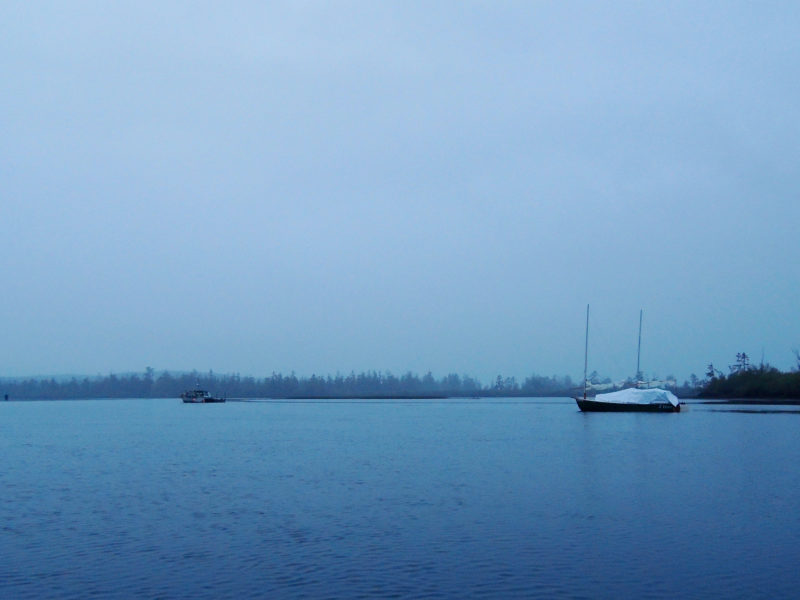 Bruce Bateau
Bruce BateauAnticipating wet weather, Frank sewed a prototype cockpit tent for WREN out of a white polytarp. It came in handy while at anchor in Blind Slough. A commercial fishing boat known as a bowpicker is to the left.
At dusk, we separated ROW BIRD and WREN and I set my own anchor nearby and unrolled my cockpit tent, securing it like a Conestoga wagon cover over three hoops between the main and mizzen masts. All night long there was a steady tapping of showers on the tent and the occasional trickle as water pooling in the creases of the cover spilled overboard.
By dawn on Sunday, the rain had lessened enough to merely dampen our gear, but not accumulate in puddles. The sky pressed down on us with thick clouds, and we lingered under our tents. The current would soon be turning in our favor, so I gave up on waiting it out and donned my raingear. Just then the clouds thinned and sunlight streaked across the sky.
We got underway and rowed slowly along the soggy edge of Marsh and Karlson islands. A half-dozen cormorants paddled through the shallows, diving and resurfacing, sometimes emerging with pencil-thick fish in their beaks. A pair of bald eagles surveyed the scene from the treetops. We didn’t encounter another boat all morning, as we wound our way through the rest of the Prairie Channel, poking into little divots and cuts into the sea of grass. The channel was so still at times that droplets falling from my oars formed pinhead-sized spheres on the river’s surface.
Around noon, the afternoon sea breeze made our westward progress slow. Although WREN had a small motor on her stern, Julie, laboring at the oars, seemed determined to reach the day’s destination under her own power. I was rowing hard myself and my shirt was sticking to my back as I rounded the west tip of Minaker Island, where the west–northwest wind would help us get to the John Day River, a tidal tributary some 10 miles away.
Julie switched places with Frank to put him to work at the oars, and WREN inched forward. When we both finally made the turn, we set sail. WREN and ROW BIRD were surprisingly similar in speed here in the protected waters upriver from Russian Island, but as we reached the edge of a water prairie, the wind waves made ROW BIRD pound, slowing my progress dramatically despite a full sail. WREN hardly took notice, cutting through the chop smoothly, leaving a bubbly wake as she sped down the South Channel.
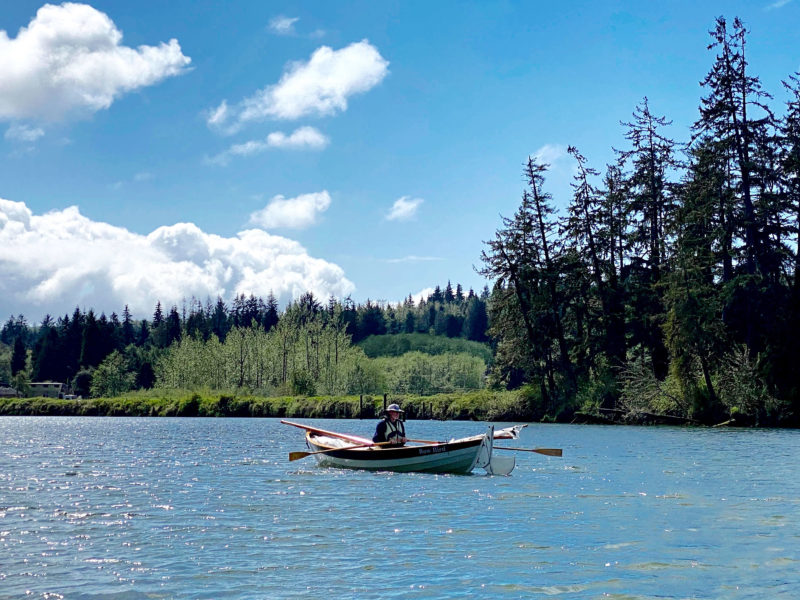 Frank San Miguel
Frank San MiguelA mild headwind made the going slow on the lower John Day River, even though I had lowered the main and mizzen masts to reduce windage. There are two rivers with this name along the Columbia, though most boaters are more familiar with the one about 200 miles upstream, on the dry side of the state.
A 150′-tall bluff, covered in emerald-green fir trees, towers over the mouth of the John Day River. To get to my friend Harvey’s dock for the night, we’d need to go upriver, past an abandoned railroad swing bridge left partially open. We arrived a little earlier than expected, and the tide was still coming out of the river instead of going in. With wind swirling near the bridge, we took to oars and pulled hard to get past the 45-yard-wide constriction between the bridge abutments. Once past them, the river widens as it flows through a broad floodplain and the current lessens, but Frank was rowing more slowly than he had been earlier and was barely moving. Julie took the oars and Frank moved aft and tugged the outboard’s starter rope. The engine gurgled to life and WREN was soon alongside ROW BIRD; I gladly accepted a tow. I stood in the back of my boat as we motored along a small lush valley where forested hillsides in shades of green from lime to jade stood in contrast to new clearcuts littered with stumps and slash.
Farther upriver, we passed floating cabins built with hipped roofs, double-hung windows, and clapboard siding, some dating to the early 1900s. Harvey’s place is nestled in a community where lawn chairs clutter the decks. After tying up the boats and retrieving the hidden keys, I unlocked his boathouse. Julie stretched out in the golden afternoon sunshine that flooded the back porch and its Adirondack chairs. We relaxed, sipped wine, and nibbled dates. At day’s end, despite the cozy cabin available to us, we opted to sleep on our boats at Harvey’s dock, preferring the convenience of having our possessions within arm’s reach.
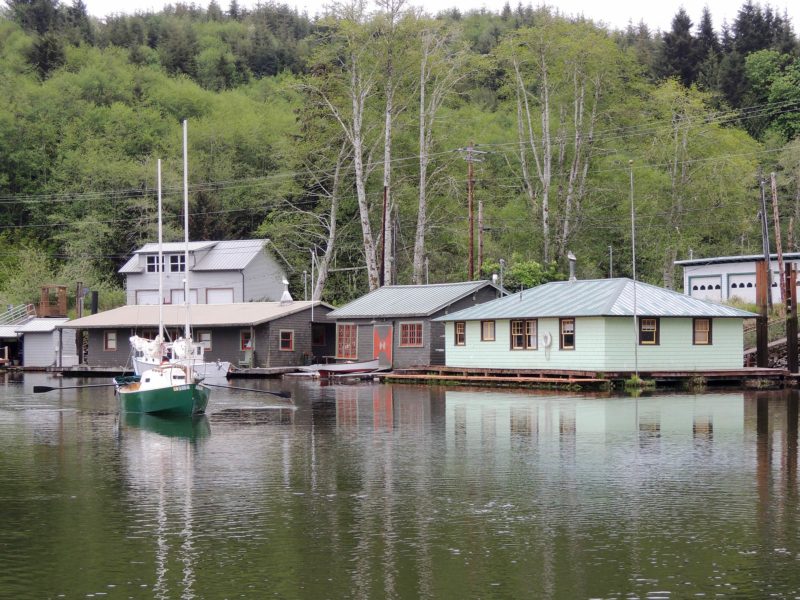 Bruce Bateau
Bruce BateauOn the way down the John Day River, WREN passed by 1920s-era floating cabins. On this third day, Frank realized that he’d left water ballast in his tanks throughout the cruise, which had made his new oars feel sluggish. Rowing was noticeably easier after he had pumped the tanks dry.
Our tour had reached the turn-around point and I was determined to play the tides perfectly on the morning of our third day. I hoped for an easy time, catching the last of the ebb down the John Day River, then 2 miles north in the John Day Channel to the 1/2-mile-wide channel entrance between Mott Island and Tongue Point, where the backwaters meet the main stem of the Columbia River. If we arrived there at slack tide, we’d be pulled upriver when the flood tide turned. We made a late start from the cabin, and when we reached the swing bridge at the mouth of the John Day River, the tide was rushing in against us, instead of pulling us out.
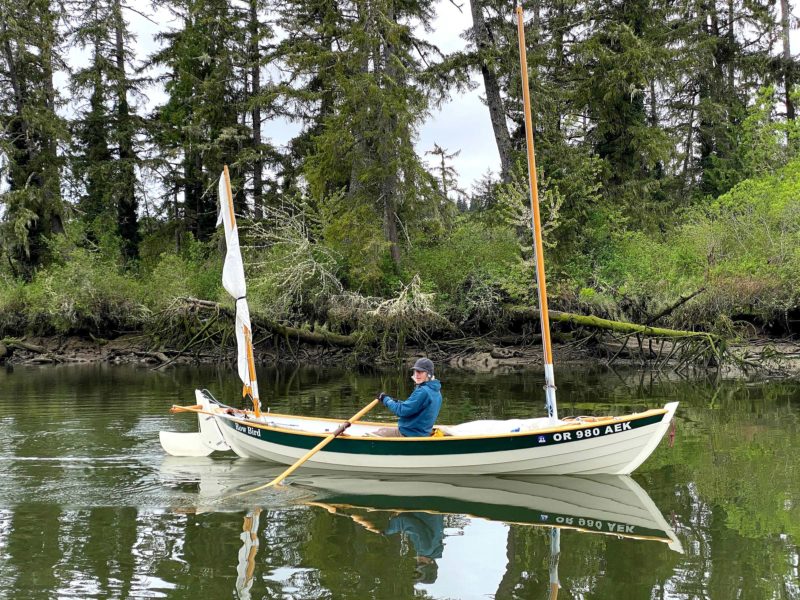 Frank San Miguel
Frank San MiguelDeparting the John Day River, I left the masts raised since I anticipated wind when we reached the more open waters downstream. I kept a careful watch for strainers, half-submerged fallen trees. They are common along the shore and dangerous when moving downriver—the current can pin boats against the branches.
The last 2 miles to the Columbia would take at least twice as long as anticipated, since we’d be bucking the tide the whole way. When ripples appeared on the channel and willow branches swayed on shore, Frank and Julie set sail, and tacked against the current, but never made headway. I’d fallen for that trap before and knew to row as fast as I could, before the full force of the tide flowed against me.
I hated to rush ahead of WREN, but I only had two days to make the 20 miles back to Cathlamet and then be home on time. If the wind and tide worked in my favor, that could easily be accomplished in one day; without that help, I’d have to battle the elements and I’d be lucky to make it home in three. When I finally reached the north end of Mott Island, I spotted dozens of fishing boats at anchor in the Columbia River, all facing west, a sure sign that the flood tide was flowing upriver. I rowed a few more strokes to get in the flow and radioed back to WREN, to tell Julie and Frank that I couldn’t wait. “If you can escape the current, I’ll see you at Skamokawa.”
A sea breeze brushed my face and started to turn ROW BIRD abeam, so I stowed the oars, and set sail up river. In the broad shallows south of the dredged ship channel, I had miles of open water to myself. There were no wakes or other boats to watch out for, but I had to navigate the sandbars that punctuate the area. When the water around the boat was dark, I sailed with centerboard and rudder down. Before long, I heard the familiar grinding sound of the centerboard hitting the sandy bottom and pulled it up. Ahead, I noticed a lighter color reflecting from a patch of sand on the bottom; up came the rudder. I steered by leaning to port or starboard. On a broad reach, ROW BIRD went faster and faster with the strengthening flood tide and an increasing westerly breeze. Fortunately, the water started to darken and deepen. I approached the ship channel just as a bulk carrier was heading upriver. Staring up at the vacant decks and three-story superstructure, I wondered if the crew even noticed my tiny craft.
Water sprayed and splashed aboard as the wind raised steep, sharp crests in the shallow water. ROW BIRD bucked and plunged as waves washed past. I was starting to feel on the edge of losing control, and had decided to heave to and put a third reef in the mainsail, when WREN appeared between me and Welch Island.
Frank and Julie used their outboard motor to escape the worst of the ebb’s adverse current, then kicked it up and started sailing upstream parallel to me on the more southerly route along the Woody Island Channel. The channel is deeper, but poorly marked. WREN has a fishfinder on the transom and they used it as a depthfinder. While he was at the helm, Julie kept an eye on the finder’s display and navigated away from shoaling water; using this method, they were able to sail quickly and safely upriver and never ran aground.
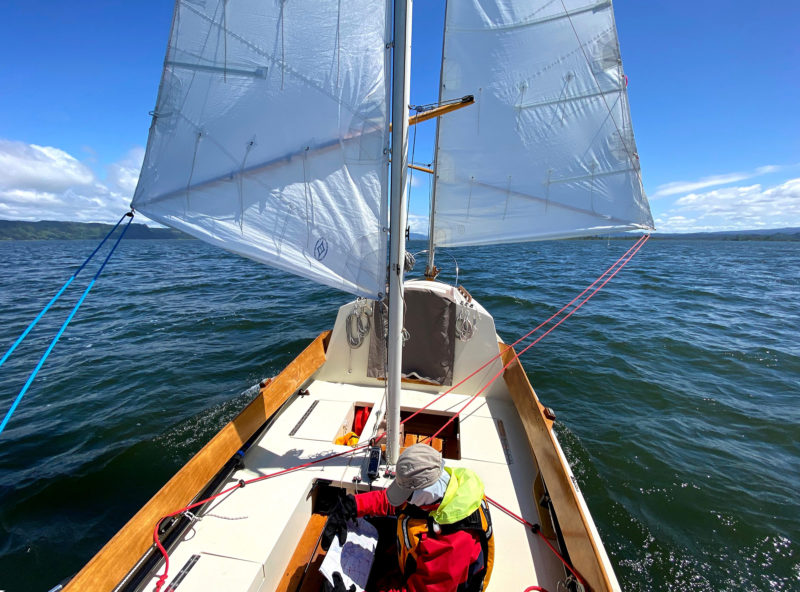 Frank San Miguel
Frank San MiguelAs Frank sailed WREN upriver along the Woody Island Channel, Julie checked the chart looking for deep water between shoals.
Another cargo ship appeared on the horizon to the west, heading upriver, and I didn’t want to tangle with it. I motioned to WREN to head toward the slough at the base of the town of Skamokawa’s historic bell tower. The ship was about 2 miles away, and we could speed across the shipping channel on a reach and slip into the backwaters that flank the town. Well before the behemoth rounded the bend in the river that runs past Skamokawa, we reached the safety of Steamboat Slough, a 100-yard-wide, 1-1/4-mile-long waterway that separates the thickly wooded Price Island from the mainland.
I hove-to alongside WREN about 800 feet into the slough, which was calmer than the river, but it still was so windy that we had to raise our voices to be heard. As we parted, our hulls grazed each other, and the wind caught WREN’s sails, sending her on a collision course with a dock on the north shore. I drifted back, hitting a mudbank just aft of them. Ultimately, no harm was done, but lesson learned: use the VHF to communicate in rough conditions.
Tired from a full day on the water, we were too worn out to row back to Skamokawa’s town center. We sailed past a two-story Victorian-era inn with tall windows and fancy wooden scrollwork, then a Craftsman bungalow with a deep porch facing the slough, but soon spruce and alder trees dominated the shoreline. We passed a lone net shed on the shore of Price Island. The roof was caved in, and its front tilted precariously toward the water. The structure and a mooring buoy were the only signs of humanity, and we decided it would be a peaceful place to spend the night.
After WREN was securely anchored at a bend in the slough with a wooded hillside to the north and the mossy forest to the south, I rafted up and climbed aboard. Julie brought out nuts and dried fruit that we munched on as we admired the view. An occasional gust shifted the boats but there wasn’t enough wind to ruffle the water. An osprey passed silently overhead, and a family of three otters scampered across the muddy shore of the island and disappeared into the brush. As dusk approached, the sky turned an indigo blue. I rowed off and set anchor a few hundred feet upstream.
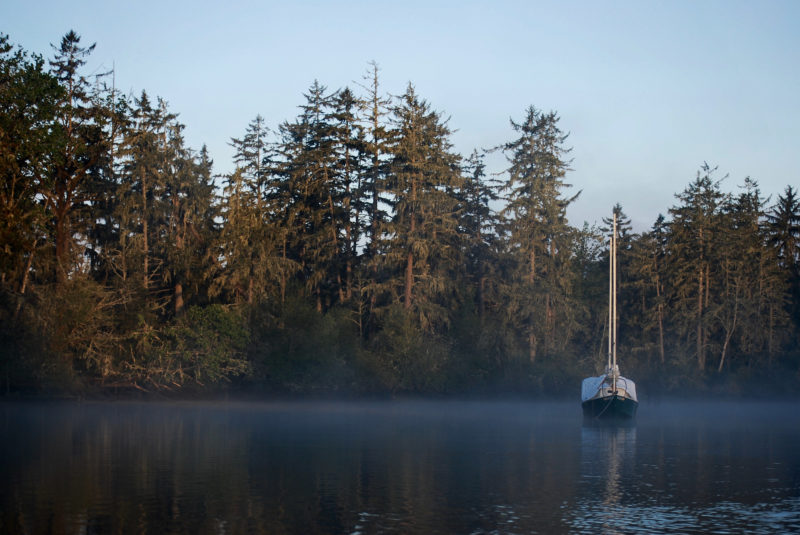 Bruce Bateau
Bruce BateauWhile WREN was at anchor in Steamboat Slough near the town of Skamokawa, the air was so still that the ground fog did not move.
Come morning, ground fog rolled across the slough, wisps and drifts of white threading through pilings capped by shrubs and between the branches of shore-side conifers. Shafts of sunlight pierced the mist, which looked like steam rising off a giant cup of coffee.
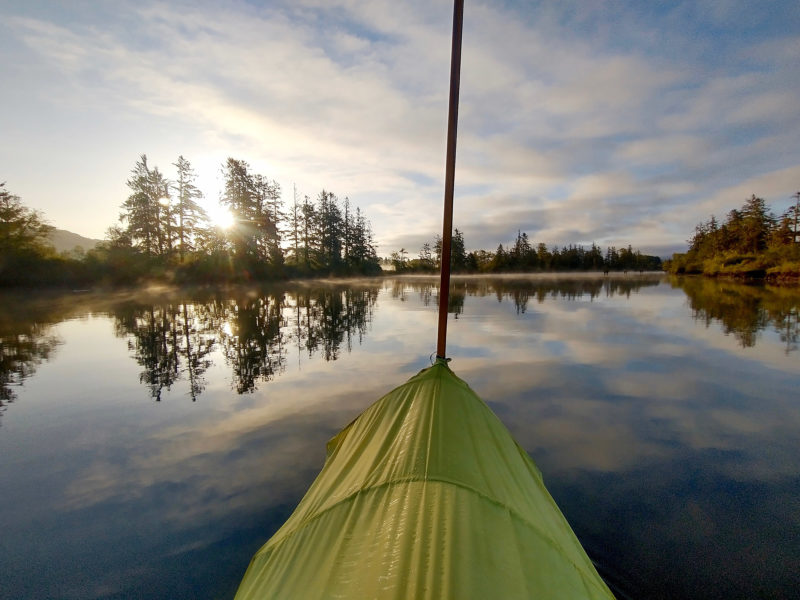 Bruce Bateau
Bruce BateauDawn is my favorite time to be on the water because the light and the sky change so rapidly. I had just rolled back ROW BIRD’s cockpit tent and stood on the mizzen deck to watch as the ground fog began to burn off in Steamboat Slough.
After it cleared, an unexpected morning northwest breeze started to blow upriver. Despite the beauty of the anchorage, the wind made me eager to get under way. Frank and Julie had another day to spend in the backwaters and seemed content to linger, but to me, the wind was my opportunity to sail home. I said my farewells and headed toward the upstream end of the slough.
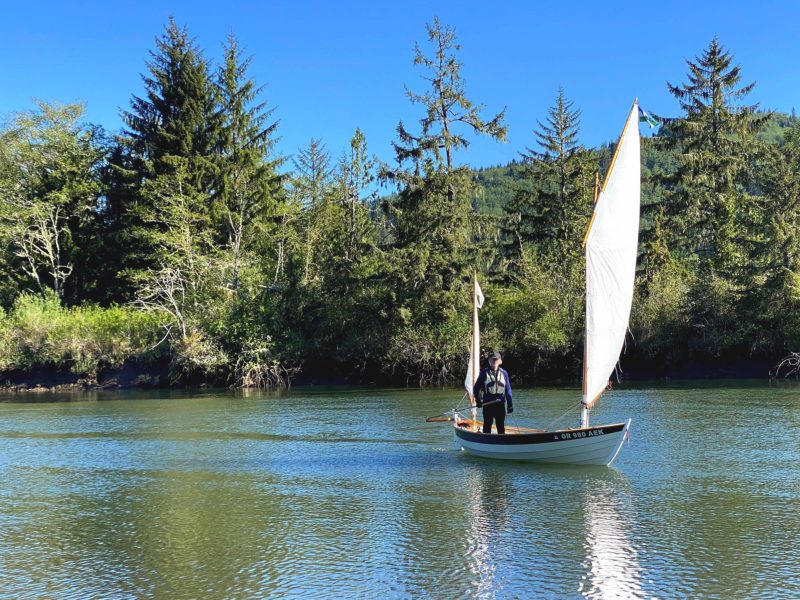 Frank San Miguel
Frank San MiguelDeparting from Steamboat Slough, I found it fun and useful to steer standing up. This gave me a good view into the water to look for shallows and snags.
A mile farther south, I reached the slough’s end and entered the main stem of the Columbia. ROW BIRD was still under full sail, with both main and mizzen drawing well, but making no progress against the current. I sat listening to the water rushing past the hull, staring at a boulder on the shore that I couldn’t get past. I was less than 4 miles from Cathlamet, and was in no hurry. Soon my sails went limp and I rowed toward shore, where I found a gentle eddy that carried me upstream to the northern entrance of Elochoman Slough.
As I circled in the eddy, unable to proceed further, I felt lucky to see this place so clearly and to have the leisure to more fully appreciate it. When the wind filled in and pushed me forward, I set sail for home, moving as slowly as possible. ![]()
Bruce Bateau, a regular contributor to Small Boats Magazine, sails and rows traditional boats with a modern twist in Portland, Oregon. His stories and adventures can be found at his website, Terrapin Tales.
If you have an interesting story to tell about your adventures with a small boat, please email us a brief outline and a few photos.
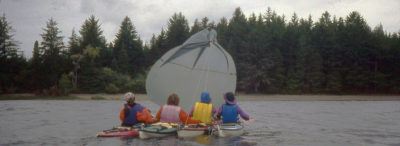
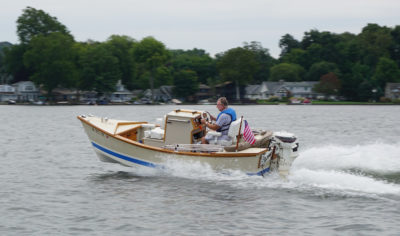
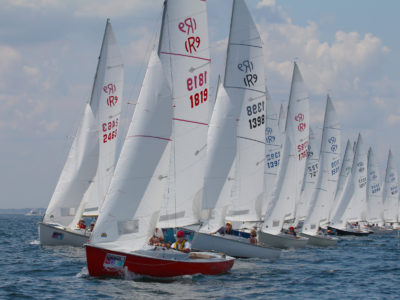
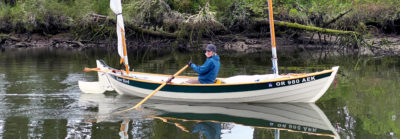
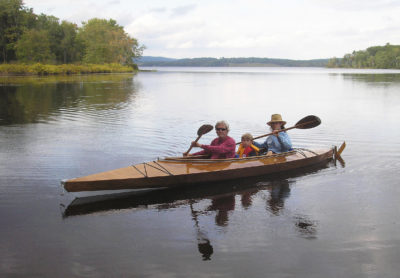
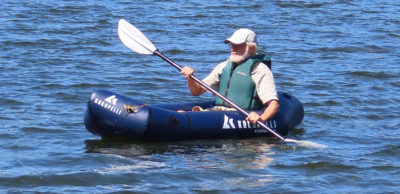
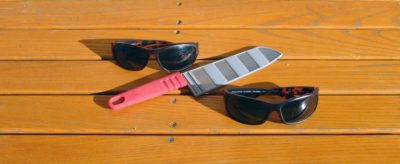
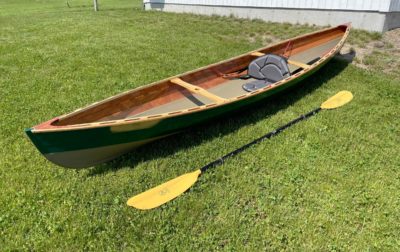
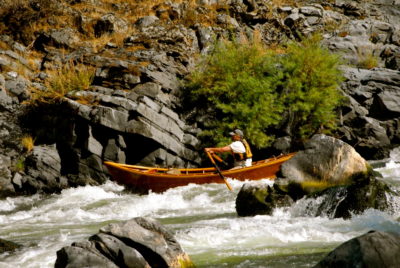
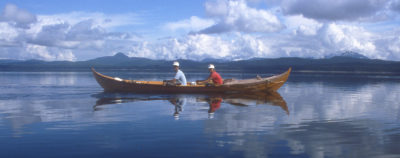
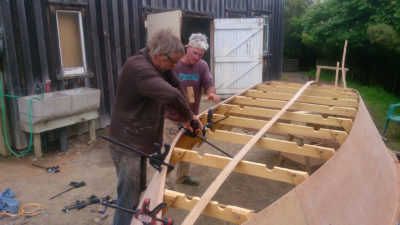
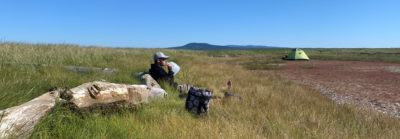
Good story, Bruce. I always enjoy your writing and the pictures of ROW BIRD.
Thanks
A nicely written, very pleasant story. I sail the Chesapeake but was almost envious of the trip and the waters.
Thanks,
John
Beautiful! I am inspired to carve out the time needed to follow in your path.
This is the first of Bruce’s articles that I have read, but I greatly enjoyed his eloquent writing that efficiently captures the mood of his scenes. Great work, and I think a very enjoyable and satisfying 4-day journey was had!
As a kid I sailed the Missisippi river above Alton Dam. We also had a lot of shallow islands and the article made me think of all the mosquitoes that would inhabit that type of terrain on the Mississippi.
Richard Simon